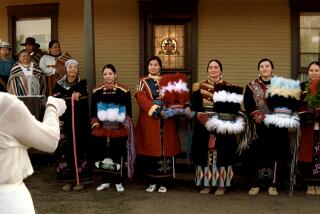A Tradition of Craftsmanship Comes Alive
- Share via
TAHLEQUAH, Okla. — To Dean Renfrow, trees are more than providers of shade.
Especially the bois d’ arc and dogwood so plentiful in northeastern Oklahoma. In these trees, Renfrow sees traditional American Indian bows and arrows. In stately walnuts, he envisions gunstocks for conventional and primitive firearms. Chunks of flint rock covering the Cookson Hills are knife blades and arrow points.
In his workshop at Williams Shooting Supply and Gunsmithing, Renfrow builds bows and arrows for hunting and display. He also builds muzzleloader rifles, repairs guns of all kinds, and gently shapes hardwoods into new stocks for rifles. In his spare time, he knaps flint into points and blades.
Each is built by hand using tools and techniques that have been used by American Indians for centuries.
Renfrow is a craftsman who takes his art to the woods and prairies for use in traditional hunting.
“I’ve always been fascinated by Native American tools and their use,” he said. “I learned to do these things through independent study.”
Though Renfrow, 45, of Wagoner, carries a Certificate Degree of Indian Blood Card from the Cherokee Nation, none of his ancestors were instrumental in teaching him the timeless crafts.
Taking a long, straight dogwood branch in hand, Renfrow runs his fingers up and down the shaft, feeling for imperfections as he tells of his search for arrow materials. Dogwood is the universal material because it grows straight, there is an abundance of it in northeastern Oklahoma, and it is strong for its size. Many years ago, the Cherokees often used cane for arrows.
“If the material has a curve to it, I can straighten it by heating and bending,” he explained. “The heat causes the wood fibers to slip past each other. When the heated wood cools, it holds in its new shape.”
From then on, it’s a matter of sighting down the wood with his eye to scrape away bark and sand the wood smooth. Next he uses elk or deer sinew to attach flint or steel points to the arrows and strengthen the nocked end of the arrow.
Fletching is goose or turkey feathers. The raw feathers are planed thin at the quill end, then split apart and placed in grooves in the arrows by hand.
“I eye them to make sure they are equal distance apart, then I glue them down,” he said. “I like mine glued down but the Cherokees didn’t glue them.”
It takes Renfrow about an hour to make a single arrow that someone might use for display purposes. Hunting arrows take more time because a set is needed.
“What you do is make up several more than you will need, then shoot them,” he said. “The ones that group [shoot in precisely the same place when aimed at a single spot] you keep for a set. Those that fly wide are used for display or individual target shooting. Two arrows that are the same size may not shoot the same.”
Renfrow’s talents don’t stop with arrows. His walks in the woods looking for bois d’ arc trees suitable for bows take hours.
“I may look at a hundred trees before I find the right one,” he said. “I look for a straight piece of wood without limbs. You can make a bow and work around knots caused by branches, but it’s better without them.”
Renfrow moves to a vise in the workshop and lights a hand-held butane torch. He’s spent a few hours roughing out a long bow from a piece of bois d’ arc. The yellow wood heats quickly, turning an umber color where the flame touches the raw wood. Using the weight of his body against the wood, Renfrow straightens a kink.
The bow’s shape is roughed out with a hand ax. He also will use a draw knife, rasp and sandpaper to smooth its surface. Some bows are backed with layers of elk sinew for strength. One of Renfrow’s personal hunting bows is backed with three layers of elk sinew from animals he has hunted.
Bois d’ arc reveals its age as years pass. Freshly made bows are yellow-gold in color. As years pass, the wood darkens to nearly black.
He also twines the strings for his bows from a single strand of Dacron.
“The American Indians used gut or sinew,” he said. “The Southwestern Indians used the Yucca plant. The Cherokees often used squirrel or groundhog hide, cutting the tanned hide in a coil that would stretch 10 feet or more.”
Renfrow always uses his own bows and arrows for hunting. An accomplished flint knapper, he makes the arrow points for hunting. The advantage of a wood bow over a manufactured fiberglass or composite bow is the satisfaction of hunting with and harvesting an animal in a more traditional way.
It’s also a quieter way of hunting compared to the compound bows that emit a loud snap when the arrow is released.
“If a bow is tuned and the arrows match [flex properly]; if the string is nocked at the proper level; and if your shooting technique is good, it’s a quieter way to hunt,” he said. “I really enjoy hunting this way.”
More to Read
Sign up for Essential California
The most important California stories and recommendations in your inbox every morning.
You may occasionally receive promotional content from the Los Angeles Times.













